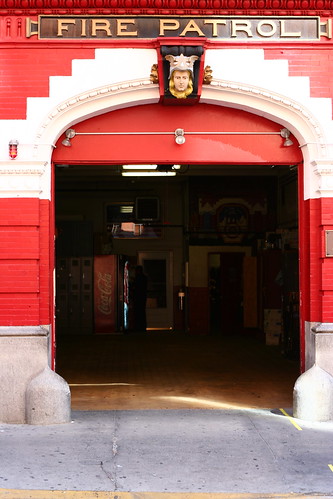Wednesday, September 07, 2005
fire patrol
Nearly every "full-blooded" Bowery male, whether immigrant or native-born, laborer or artisan, belonged to a fire company. These volunteer organizations were para-political, para-fraternal entities, organized by neighborhood, by ancestry. Like army divisions, they were formally numbered but were actually known by allusive nicknames: Big Six (famous for being Boss Tweed's company), Black Joke, Old Rock, Charter Oak, Americus, White Ghost, Shad Belly, Dry Bones, Red Rover, Hay Wagon, Bean Soup, Old Junk. -- from Low Life by Luc Sante.
The municipal fire service began in 1865 and eventually replaced the fire companies. But the insurance companies had started the move to a professional service in the 1830's when the Fire Patrol was created.
Fire Patrol is not the FDNY, although their jobs are just as dangerous. This Patrol house dates from 1907.
From The Wall Street Journal Mar 16, 1987:
NEW YORK -- Garbed in black fire-resistant coats and heavy red helmets, sirens on their red trucks wailing, three crews from the New York Fire Patrol race to an early-morning fire in an office building. They aren't firefighters. Their trucks carry no hoses or other equipment for dousing flames.
Instead, the fire patrolmen troop into the burning building and set about protecting the interests of their private-sector employers: insurance companies that write fire policies. Working mainly on the two floors directly below the firemen and the fire, the patrolmen deploy heavy canvas tarpaulins and electric pumps to minimize water and smoke damage -- and thus cut insurance claims.
Almost unknown to city residents, the New York Fire Patrol has been rushing to fires here since the 1830s. It traces its roots back even further, to 1803, when merchants organized the Mutual Assistance Bag Co. to haul out goods from one another's premises (in bags) during fires. The patrol, in fact, predates the city's paid fire department.
Once there were fire patrols in more than 20 American cities. But for 25 years, since closings in Chicago, Philadelphia and Baltimore, New York's has been the only one. London insurers ended a similar operation in 1983.
Patrol House 2, shown above, in Greenwich Village, is located opposite the site of a house where Edgar Allen Poe used to live. It is, apparently, haunted.







